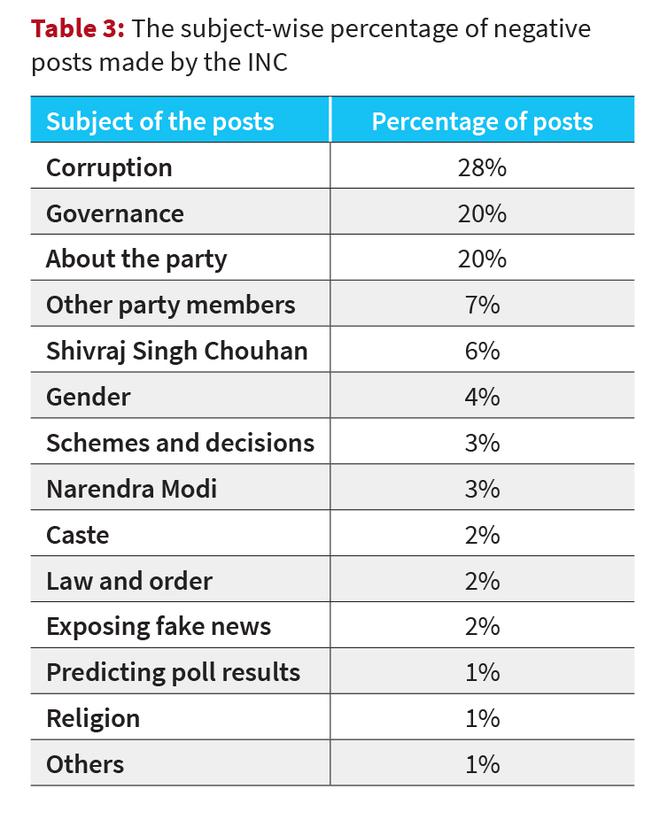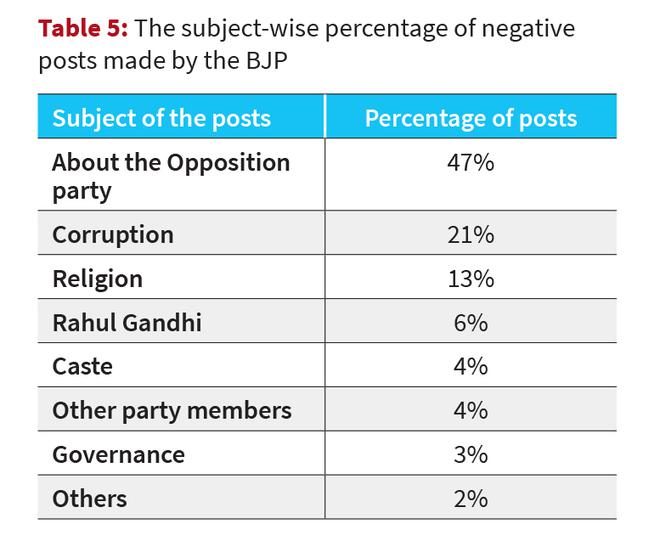Madhya Pradesh has mostly been a Bharatiya Janata Party (BJP)-ruled State since 2003, with the Indian National Congress (INC) forming the government for a brief period between December 2018 to March 2020. As the State goes for elections on November 17 for all 230 assembly seats, social media has become an important platform for campaigning and garnering votes. The purpose of this study by the Lokniti-CSDS is to understand and contrast the kind of posts made in the run-up to the elections by the two major parties and their members.
Categorising posts
A total of 24 accounts were monitored, 12 from the BJP and 12 from the INC. These accounts included the handles of senior party leaders, Opposition party members, MLAs, party workers, State official accounts and party supporters. All the posts recorded were from the social media platform, X (formerly known as Twitter). The recorded posts were categorised as positive, negative, neutral, and mixed. The posts were categorised as positive if they were about the accomplishment of the party and negative if it included posts criticising the other party for their shortcomings. Neutral posts included general updates about visits and greetings. The mixed category had posts which were simultaneously commending the party and attacking the other party (Table 1).

The reach of the Congress
Out of the 1,000 posts recorded, 500 were by the INC and 500 were from the BJP. From the posts, it can be observed that the INC had a more robust social media presence in Madhya Pradesh as compared to what was observed by Lokniti in its studies in Rajasthan and Chhattisgarh. Around 34% of the total posts recorded were videos and 49% were photos.
One of the most active accounts overall was the party’s official State account — @INCMP on X. Out of the total posts made by the account, 42% were negative, 42% were positive, and 15% were neutral. The online campaign of the @BJP4MP seems to be rather subdued and more focused on positive propaganda, which is in stark contrast to its vigorous approach in the States of Chhattisgarh and Rajasthan. The most active informants in the BJP sample in Madhya Pradesh were the Chief Minister’s handle accounting for 33% of posts, senior party leaders (30%) followed by the official party account @BJP4MP (17%) and others. The party appears to be primarily focused on amplifying its schemes and achievements.
The top categories of INC’s positive posts were about the manifesto, public speeches, poll results, and personal image. The positive posts about the manifesto included various schemes and decisions the INC will bring into fruition in the State if it is elected. The manifesto includes healthcare schemes, job opportunities, provisions for education, the Old Pension Scheme, distributing cylinders for ₹500, free 100 units of electricity and so forth. Among the most frequently used slogans by the party were ‘Badhaiye Haath, Fir Kamal Nath’ and ‘Congress Ayegi, Khushali Layegi’(Table 2).

The negative posts by the INC were overwhelmingly about corruption in the State, misgovernance, and about internal strife within the party. The rampant corruption in the State was one of the major criticisms taken up by the INC against BJP. Such posts included allegations about the 50% commission taken by the Shivraj Singh Chouhan’s administration, the Patwari recruitment scam, the midday meal scam, the mahakal lok scam, the sarva shiksha abhiyan scam etc (Table 3).

Hashtags and slogans such as ‘#Shivraj_Ghotalaraj’ and ‘Madhya Pradesh Ne Thana Hai, Jungle Raj Hatana Hai’ widely used by INC party accounts further focused upon the issue of corruption within the State.
The governance under BJP, or the lack thereof, was another case in point highlighted by the INC in its social media campaign. The issues taken up by the party included a myriad of problems such as the delay in salaries for guest teachers and MGNREGA employees, inflation, farmers’ concerns, unemployment etc.
A look at the bright side by the BJP
The BJP appears to have a different campaign strategy online. Out of the total positive posts made by the BJP, about 25% were about its achievements in governance. A lot of focus seems to be on central government schemes such as the PM Awas Yojana. Another 25% of tweets were party fanfaronade, with several video excerpts of roadshows, rallies and testimonials of the general public being posted frequently. In a strategy similar to the BJP in Chhattisgarh and Rajasthan, Prime Minister Narendra Modi and Union government schemes seemed to be the anchor of the campaign. Almost 15% and 13% of the total positive posts were about him and central government schemes respectively (Table 4).

Hashtags like ‘#MP_ke_Mann_Mein_Modi’, “MPwithModiji” ‘#LadliBehna’ and CorruptionNath were trending on X.
Almost 8% of the tweets were about women and their empowerment. These tweets were almost always posted in the light of the MP government flagship scheme “Ladli Behna Yojana ‘’ which promises a monthly assistance of ₹1,250. There were mentions of several other schemes and policies for the welfare of women. The 2% of religious posts were mostly about the inauguration of the Ram Mandir, while 2% posts were about caste. Multiple posts featured PM Modi’s statement in a rally in Sidhi wherein he said, “Poori congress mujhe gaali dekar poore OBC varg ka apmaan kar rahi hai“ (Congress has insulted the entire OBC community by insulting me).
Almost 47% of the negative posts made by the BJP were predominantly attacks on the Congress party and its leadership on the grounds of misgovernance and shoddy politics. The allegations of corruption were featured in almost 21% of posts (Table 5).

The BJP made multiple posts levelling corruption allegations, such as the Karzamaafi Ghotala to the tune of ₹3000 crore, Jal Sansadhan Ghotala and Krishi Ghotala among others. There were almost 13% posts on religion with a majority of the posts targeting the party for being ‘anti-Sanatan’. The negative posts about caste were targeting the divisive politics of the INC.
More focus on women, religion, caste
There was an emphasis on women by both the INC and the BJP. This can be better understood in the light of the fact that the female voter base in Madhya Pradesh is a whopping 2.72 crore (48%) according to the 2018 Assembly Election figures.
The BJP made several posts regarding the welfare of women. The party amplified its Ladli Bhena Yojana through its online campaign. In order to outdo this move by the Shivraj Singh-led administration, the INC has promised to provide a monthly aid worth ₹1,500 to women as a part of its larger blueprint for empowering women in the State. Despite this the BJP has given tickets to only 25 female candidates whereas the Congress has given tickets to 30 women, which is less than 15% of the total seats.
Additionally, both parties have made significant number of posts criticising each other by highlighting the internal strife within the parties. There have been multiple instances wherein party workers on both sides protested against candidature and senior party members. One of the most notable cases is that of Jabalpur where BJP party workers heckled Union Minister Bhupendra Yadav.
Moreover, on the other side of the court, alleged INC party supporters burned effigies of former Chief Minister Digvijaya Singh in Bhopal.
The parties posted a significant volume of tweets with religious undertones. The BJP tweets were pertaining to Ram Mandir and the “anti-Sanatani” Congress. There were also multiple tweets regarding caste by both the parties. The BJP has given tickets to 68 OBC candidates whereas the INC has given it to 59.
With the elections just around the corner, these trends and observations may be subject to change. These findings thus provide a preliminary overview of how political parties use social media platforms as a means of communication and campaign tool in the runup to the elections.
Sanjay Kumar is a Professor at CSDS, Aditi Singh is an Assistant Professor at O.P. Jindal Global University, Kaushiki K. Singh and Avika Singh are short-term researchers with Lokniti-CSDS







